Sales Funnel: Why You Need it For Any Marketing Strategy
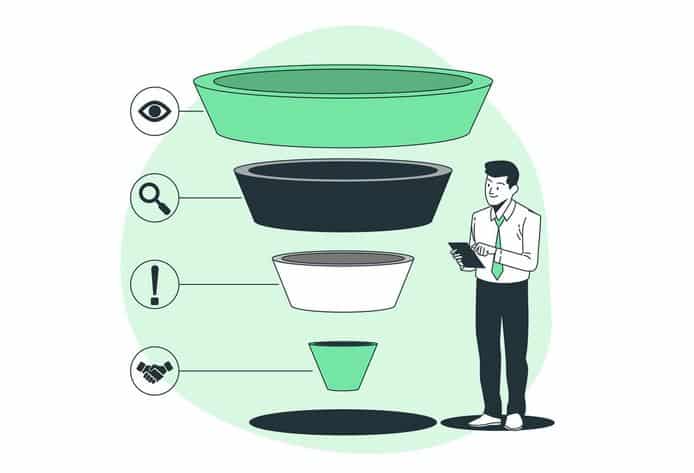
If you don’t have a sales funnel in 2023, you might as well close up shop. Harsh but true!
In today’s digital marketing landscape, an effective sales funnel is indispensable for sales success. It optimizes your sales strategy by moving qualified prospects through the stages to become customers.
This article explains what a sales funnel means and why your business needs a customized funnel to boost overall sales. You’ll learn the purpose of each sales funnel stage and how it nurtures leads toward a purchase.
We’ll also address common cracks in your funnel and ways to fix them. By the end of this article, you’ll have actionable tips to help you build a successful sales funnel.
Ready to supercharge your sales and marketing efforts?
Let’s dive in and unlock the secrets to sales success!
What is a Sales Funnel?
You just heard me mention “sales funnels” a bunch of times. But what exactly does that term mean? Here’s a simple rundown:
- A sales funnel is basically a mapping of your customer’s journey from when they first become aware of your product or service to when they hopefully make a purchase.
- It lays out the main steps and stages a potential customer goes through before (hopefully!) deciding to buy. Four main stages make up the sales process for a sales funnel.
Here’s a quick visual to illustrate the concept:
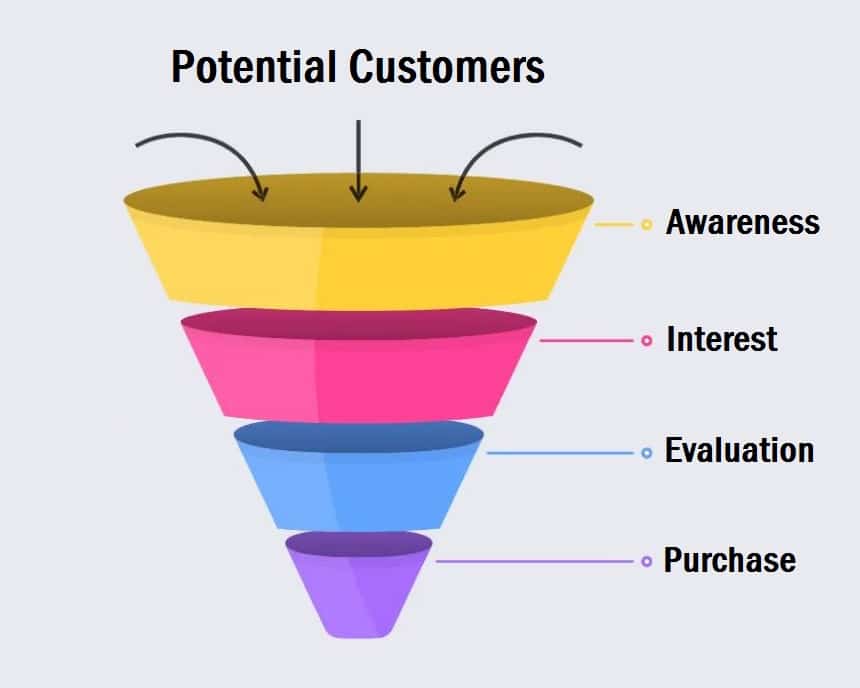
As you can see, the stages get narrower – just like a real funnel!
- The first stage casts a wide net on various marketing channels to inform potential buyers of your offer.
- The next two stages warm them up, get them more engaged, and guide them to evaluate if your product solves their needs.
- Finally, some prospects will make a purchase and become customers!
Not everyone will keep moving through each stage – and that’s normal. The key is maximizing conversion rates at each step of the sales process.
A sales funnel enables you to track where potential buyers are falling out so you can optimize. Pretty cool, right?
When you map out this entire progression, it creates a sales funnel that systematically captures, nurtures, and converts leads.
Understanding the Four Sales Funnel Stages
Let’s talk about the stages of a sales funnel in more detail. Understanding and optimizing them is key to creating a high-converting sales funnel for your business.
Here are the four different stages of a sales funnel:
Stage 1: Awareness
The Awareness stage is about initially getting on the radar of potential new customers. You want to create and put out something to attract their attention and make them realize, “Hey, this product/service could be useful for me!”
Some key tactics include:
The goal is visibility. You want prospects to learn about what you have to offer.
Stage 2: Interest
The Interest stage is when you’ve sparked some intrigue and now need to help visitors see how you can solve their specific pain points.
You have to nurture the interest with valuable content. This stage of the funnel is all about capturing contacts and building genuine connections.
Here are some tips:
- Offer educational resources, tipsheets, product demos
- Collect lead contacts with call-to-actions like “Download now!”
- Send personalized email drip campaigns to warm up subscribers
Keep providing value before asking for the sale!
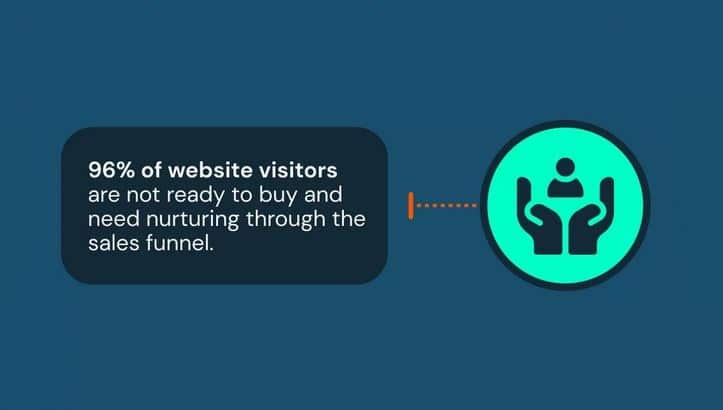
Source: zipdo.co
Stage 3: Evaluation
The Evaluation stage is when leads are engaged and evaluate if you’re the right fit before buying. They want to be sure about how your product can help them. Some marketing experts also call this stage the ‘decision stage.’
It’s time to prompt action with:
- Free trials to showcase the user experience firsthand
- Webinars/sales calls to address concerns
- Client testimonials to showcase ROI
The key is overcoming objections and conveying true value. Guide buyers closely to finalize that purchase decision.
Stage 4: Purchase
The Purchase stage is the final stretch to close the deal. Remove all barriers by streamlining the buying experience. You must try to guide leads over the finish line to become customers.
Here are some tips to optimize ongoing sales:
- Make buying seamless with online checkout/forms
- Offer pricing tiers and conditions to meet varying budgets
- Provide exceptional support and resources post-purchase
Handling this stage well opens opportunities for repeat business and referrals down the line.
Aligning Sales Funnel Stages With the Customer Journey
When mapping your sales funnel, it’s crucial to tailor it to your potential customer’s actual path – their journey as they progress through the funnel from initial awareness to purchase.
You must meet leads where they are and guide them through natural next steps that make sense. This is how to progress visitors through the stages seamlessly:
- Awareness: Focus on questions and pain points common early on. Draw people in with content that provides initial solutions.
- Interest: Demonstrate how you can address broader issues a lead cares about. Establish your authority and ability to deliver value.
- Evaluation: Directly tackle the specifics that matter most to leads evaluating solutions. Convey detailed ROI, case studies, and demos.
- Purchase: Make the buying experience easy and confidence-instilling. Emphasize ongoing support and resources.
See how the messaging and offers align with where visitors are mentally? You educate and prompt action based on the specific stage of the sales funnel.
This customer-focused approach is integral for an effective sales funnel that actually moves people down the pipeline. It meets website visitors where they are instead of taking a rigid, one-size-fits-all tactic.
Understanding the true customer journey and tailoring content to each transition is key for funnel success. This guides leads through the complete cycle to purchase and beyond!
Successful Transitions Between the Stages of a Sales Funnel
Now that we’ve mapped out the stages, let’s look at how to create effective transitions from one to the other.
Awareness to Interest
A company selling project management software could transition visitors from initial awareness to interest by:
- Offering an ebook on productivity tips for teams after a blog post
- Running ads with a case study on deliverables being met faster with their solution
- Collecting emails for subscribers to receive more ROI data
These activities nurture leads by demonstrating tangible value.
55% of surveyed B2B marketing professionals in the US ranked articles and blog posts as the most effective type of content for progressing prospects through the sales funnel.
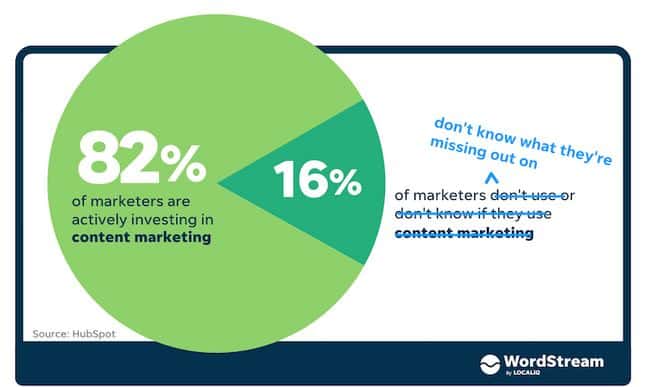
Source: wordstream.com
Interest to Evaluation
To graduate customers evaluating solutions, a company could prompt engagement with:
- Interactive product tour webinars and videos
- Free trials to experience the platform firsthand
- ROI calculators showing potential time/cost savings
This enables informed purchasing decisions.
Evaluation to Purchase
To convert leads ready to buy into customers, some final tactics include:
- Side-by-side pricing tiers with all features
- Support rep contacts for quick questions
- Case studies on implementation and adoption
This gives visitors what they need to maximize purchase confidence and hit the buy button.
Do you see how tailored, relevant messaging at each step effectively moves visitors through the funnel? It meets them where they are mentally and pushes natural progression.
Overall, strategic coordination of each transition is what transforms casual visitors into lifelong customers. Aligning with the customer journey makes all the difference in marketing campaigns.
Why Are Sales Funnels Important for Businesses?
Hopefully, you now see what a sales funnel is and how effective it can be. But why exactly is implementing a customized one so valuable for your business?
Here are some key reasons:
1. Maps the Buyer’s Journey
As we have seen earlier, a funnel mirrors the typical path prospects take to purchase. It meets their needs and pulls them towards each progression.
Understanding this journey is essential to connect with visitors and enhance sales performance.
2. Optimizes Lead Conversion
Each outreach phrase should convert visitors from strangers to leads, lead to qualified buyers, and buyers to customers.
A structured funnel helps streamline sales processes. It maximizes how many move forward at each point through deliberate messaging and sequencing.
3. Pinpoints Weak Points
Drilling into conversion rates and drop-off points lets you instantly spot where visitors lose interest or questions arise. Fix these cracks with tailored content to propel more through the entire process.
4. Enables Personalization
Crafting targeted offers, advice, and prompts for each user based on their phase makes information feel relevant. This level of personalization keeps visitors engaged in their journey.
For example, someone requesting a free trial may get an email series on product capabilities, while a recent sign-up receives onboarding tips. Meet leads where they stand.
5. Facilitates Follow-Up
Collecting visitor contact info allows you to nurture leads across devices continually. Remarketing emails, social ads, and more reinforce messaging after someone leaves your site. This brings them back into the funnel.
6. Provides Marketing Intelligence
In-depth metrics on digital behavior, content consumption, referral sources, and sales by phase equip you to refine approaches. Funnel intelligence is marketing gold for continual optimization.
7. Future-Proofs Strategy
An effective funnel today will still work tomorrow…with a few tweaks. As needs evolve, you realign parts of your funnel strategy to match buyer mentality, but the underlying structure remains highly effective.
8. Strengthens Customer Relationship Management
A sales funnel creates opportunities to connect with potential and current buyers at every stage. By offering high-value information tailored to each phase, you foster positive relationships grounded in helping, not just selling.
Sales teams can access data to have more meaningful interactions and facilitate great customer service. Modern customer relationship management is powered by sales funnel data tracking customer needs over time.
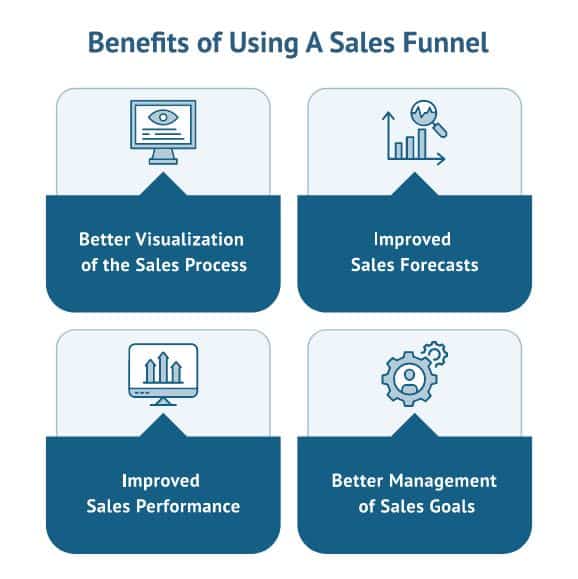
Source: fitsmallbusiness.com
Steps to Building a Sales Funnel
Let’s discuss the actionable steps you should take to create a successful sales funnel tailored to your product or service.
Step 1: Identify Business Goals
Get crystal clear on your overall objectives. Do you want to boost overall deals? Shorten sales cycles? Reduce churn? Increase call volume? Getting clear on your goals will help you define your target audience.
Funnel KPIs need to align with business goals. Identifying business goals is the foundation of good sales funnels.
Step 2: Map Your Buyer’s Journey
Conduct buyer research and interviews to understand your typical customer journey. Analyze their key questions, objections, and motivators during their research process. Get inside their head!
Step 3: Chart Your Funnel Stages
Sketch out the natural stages prospects move through on their way to becoming customers.
Awareness > Interest > Evaluation > Purchase
But feel free to customize stages to your unique sales path!
Step 4: Build Conversion Funnels
Determine the specific pathway prospects take through your site to convert. And tailor messaging to guide them step-by-step.
For example:
Blog Post > Content Upgrade > Email Sequence > Webinar Registration > Free Trial > Purchase
Step 5: Create Matching Content
Develop tailored content that speaks to leads in each stage – video overviews for initial research, detailed feature sheets for evaluating tools, ROI calculators showing payoff, etc.
Step 6: Analyze and Optimize
You must continually analyze and optimize your sales funnel. Track visitors across devices to see engagement, drop-off rates, and conversions. Refine weak points and double down on what’s working via A/B testing.
A/B testing ad headlines led to a 12% revenue growth for Microsoft Bing.
Implementing an intentional sales funnel takes some upfront strategizing but pays off exponentially. Start mapping your customer’s journey today!
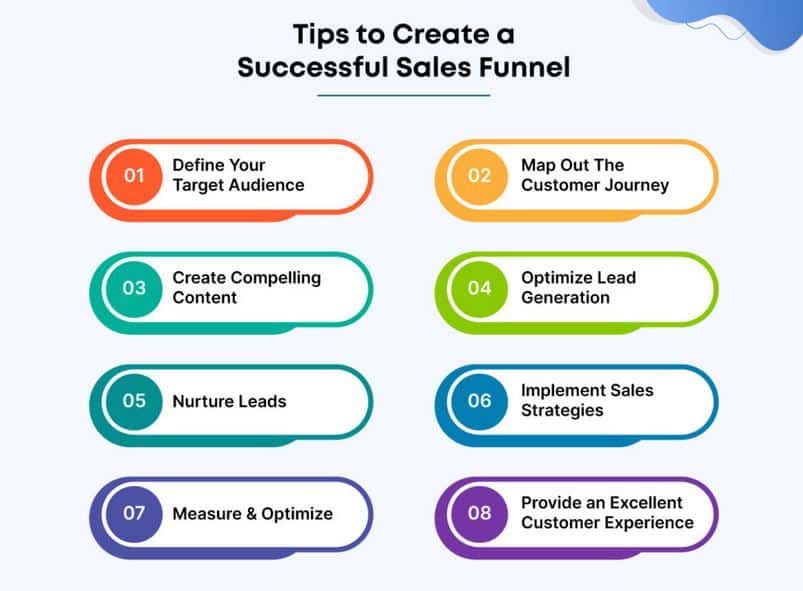
Source: softwaresuggest.com
Sales Funnel Management
Constructing an effective funnel is crucial – but ongoing optimization is what drives continuous growth. Here are the best practices for managing your sales pipeline:
Sales Data Tracking
Robust analytics provide the fuel for refinements. Be sure to implement tools to help collect key metrics across interactions, including:
- Google Analytics – traffic volume, behaviors, conversion tracking
- CRM – lead details and communications sent
- Ad platforms – impressions, clicks, conversions
- Email marketing service – open rates, content downloads
- Attribution tracking – cross-channel customer journeys
According to McKinsey, over 30% of sales tasks can be automated. Arming marketing and sales reps with quantitative pipeline intelligence facilitates better decisions.
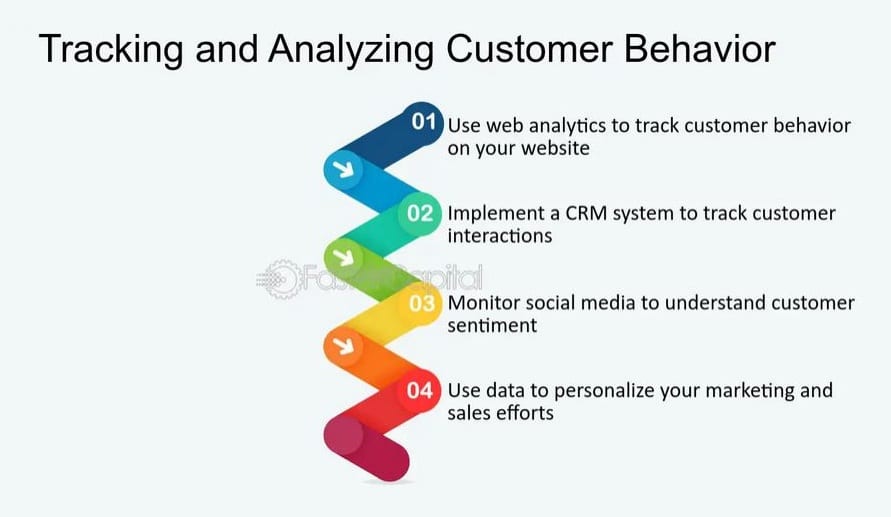
Source: fastercapital.com
Interpreting Metrics
With clean sales data in hand, conduct regular analysis to uncover optimization opportunities. Review:
- Content consumption trends – what resonates?
- Conversion rates by campaign, ad sets, keywords – where do drop-offs happen?
- Multichannel attribution – what first inspires action?
- Funnel stage velocity – are prospects journeying as expected through the cycle?
- Lead quality evaluation – how sales-ready are marketing hand-offs?
Identifying areas working well and those missing the mark helps focus improvement efforts for an overall lift.
Implementing Improvements
Finally, activate changes across the funnel based on what the data reveals. This can involve updates like:
- Refining underperforming landing pages
- Tightening ad targeting parameters
- Adding more supporting assets to aid decisions
- Adjusting email nurturing cadence
- Improving lead-scoring rules
Rinse and repeat for a constantly optimized sales machine!
Following this methodology keeps your eyes on the right funnel metrics to actively boost revenue month over month.
Addressing Cracks in Your Sales Funnel
Even the most robust funnels can spring leaks as buyer preferences evolve. Here are constructive ways to tackle common cracks:
Misaligned Offers
Over time, an opt-in lead magnet may no longer speak to visitor pain points. Refreshing these to deliver renewed value keeps prospects engaged through the start.
For example, a marketing agency may update its initial checklist from “10 Tips for Facebook Ads” to “Guide to TikTok Marketing” to capture more modern demand.
Message Mismatch
Does your email/video content still resolve their questions as you nurture leads toward a sale? Repurpose resource materials to address dead-end obstacles.
Are prospects unsure how your software integrates with specific tools? Create new transition content spotlighting those integrations to move more evaluators forward to the purchase stage.
Poor Page Performance
Run A/B tests on key landing pages to see if new layouts, copy points, or supporting materials improve conversions over older versions.
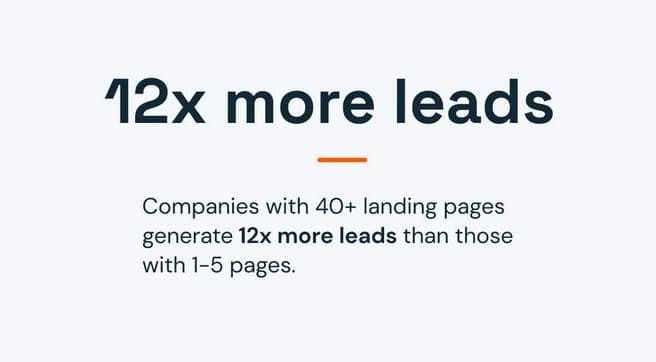
Test and optimize your page speed. For maximum funnel efficiency, studies show page load time should ideally be 0 – 2 seconds.
Testing small tweaks often reveals big wins to plug pipeline leaks.
In essence, align your funnel’s offers, information flow, and pages to ever-evolving buyer needs. This refinement converts more visitors who enter the top of the funnel into delighted customers at the bottom of the funnel.
Conclusion
Putting together a sales funnel is crucial now for business growth. This step-by-step process for leading customers from “hello” to sale drives bigger revenue.
We discussed why you need a sales funnel and mapped out how to outline the path target buyers take – from finding you to becoming loyal customers!
You must always refine your sales funnel strategy based on real user data to plug any weak points. Tight integration with your CRM and analytics makes funnel optimization easy.
With a smooth-flowing funnel powering your broader marketing, your messages will kick more sales into high gear.
Leveraging ads is particularly effective for drawing potential new customers into the top of the funnel. At AdvertiseMint, we can use our paid social media ads services to help you gain highly targeted leads.
Want the right people to know about your product or service and eventually become paying customers?
Our ads specialists can help make that happen. We’ve partnered with many businesses like yours and consistently delivered good ROI. We want to do the same for your business.
Get the ball rolling by having a consultation with one of our ads specialists.
Click here to request your FREE Facebook ads consultation now!
